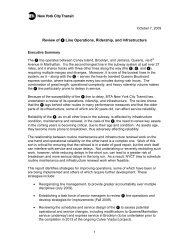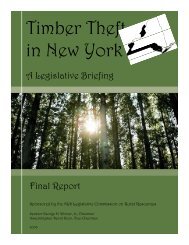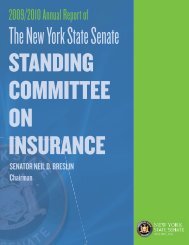Crime Committee Report e.indd - New York State Senate
Crime Committee Report e.indd - New York State Senate
Crime Committee Report e.indd - New York State Senate
Create successful ePaper yourself
Turn your PDF publications into a flip-book with our unique Google optimized e-Paper software.
The landmark Family Protection and Domestic Violence Intervention Act of 1994 created<br />
a framework to promote a more aggressive response to domestic violence. A statewide computerized<br />
registry was established to expedite communication between Family and Criminal<br />
Courts and law enforcement agencies. Only orders of protection for domestic violence offenses<br />
covered under the statutory definition of family offense, however, are put on the registry. At<br />
least half of the victims of domestic violence are persons outside the statutory definition of<br />
family. Orders of protection and temporary orders of protection issued to protect these victims,<br />
now covered under the 2008 legislation which expanded access to Family Court, should also be<br />
included on the computerized statewide registry.<br />
S.5517 HASSELL-THOMPSON<br />
Commitment Documents<br />
This bill would correct and clarify inconsistent and ambiguous provisions in the Criminal<br />
Procedure Law and the Correction Law pertaining to the timing of the sentencing court’s<br />
obligation to provide state and local correctional facilities and OCFS facilities with commitment<br />
documents, orders of protection and sentencing minutes. It also would make technical<br />
corrections to the statutes to reflect the proper name of the commitment documents that are<br />
used today. First, Criminal Procedure Law § 380.60 identifies a “certificate of conviction” as the<br />
legal document that confers the authority for the execution of sentence and serves as the order<br />
of commitment. In actuality, the technical title of the commitment document is a “sentence<br />
and commitment.” As such, it is appropriate that this section of law, as well as a comparable<br />
provision in Correction Law § 601(a), be amended to include the title of the document that is<br />
routinely used.<br />
Second, Criminal Procedure Law § 380.70 provides that in any case where a person receives<br />
either a determinate or indeterminate sentence of imprisonment, the sentencing minutes must<br />
be transcribed and separately sent to the institution to which the defendant has been delivered<br />
within 30 days of the pronouncement of sentence.<br />
As part of the Sentencing Reform Act of 1995, the Legislature determined that the commitment<br />
document that accompanies an offender to his or her place of incarceration should<br />
contain greater specificity with regard to the crime of commitment. Specifically, it was determined<br />
that the commitment should also indicate, to the extent applicable, the subdivision,<br />
paragraph and subparagraph of the penal law or other statute under which the defendant was<br />
convicted. However, when the Legislature adopted this new requirement in 1995, the provision<br />
was mistakenly inserted into section 380.70, the same section of law that deals with sentencing<br />
minutes. This creates the misimpression that a commitment, like the sentencing minutes, may<br />
be separately delivered to the facility, even though Correction Law § 601(a) and Criminal Procedure<br />
Law § 380.60 make it clear that the commitment document must accompany the defendant<br />
when he or she is delivered to the institution to commence serving his or her sentence of<br />
imprisonment. This error was continued when the law was subsequently expanded to require<br />
orders of protection to be delivered to the institution with a defendant.<br />
The new section of law that explicitly describes the documents that must accompany a defendant<br />
when he or she is delivered to an institution to commence serving a sentence of imprisonment<br />
will clarify the confusion that is caused by the existing, inconsistent statutory language.<br />
This will help to ensure that state and local correctional facilities have the necessary documentation<br />
when receiving offenders into their custody, including documents providing such basic<br />
information as the term of the inmate’s sentence and whether multiple sentences run consecutively<br />
or concurrently.<br />
At the same time, maintaining a separate section of law requiring that courts subsequently<br />
send the sentencing minutes to the facility should help to clarify the courts’ continuing obligations<br />
after a defendant has been sentenced. These minutes assist DOCS and the Division of Parole<br />
with programming and release decisions. They provide additional background about the<br />
70<br />
<strong>New</strong> <strong>York</strong> <strong>State</strong> <strong>Senate</strong>









![[PDF] Proposed MTA Capital Program - New York State Senate](https://img.yumpu.com/24854139/1/190x245/pdf-proposed-mta-capital-program-new-york-state-senate.jpg?quality=85)






